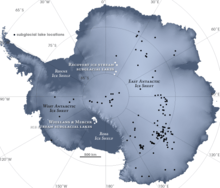Lake Whillans
| Lake Whillans | |
|---|---|
| Coordinates | 84°15′S 153°30′W / 84.250°S 153.500°WCoordinates: 84°15′S 153°30′W / 84.250°S 153.500°W |
| Type | Subglacial |
| Basin countries | Antarctica |
| Surface area | 60 km2 (20 sq mi) |
| Average depth | 2 m (7 ft) |

Lake Whillans is a subglacial lake in Antarctica. The lake is located under the Whillans Ice Stream at the southeastern edge of the Ross Ice Shelf in the west of the continent. The lake surface is 800 m (2,600 ft) beneath the surface of the ice and the lake covers an estimated area of 60 km2 (20 sq mi). Lake depths measured thus far have been around 2 metres (7 feet).[1] Its temperature is −0.49 °C,[2] below 0 °C because of the high pressure.
Lake Whillans, like the Whillans Ice Stream, is named for Ohio State University glaciologist Dr. Ian Whillans.
Discovery
The lake was first described in 2007 by Helen Fricker, a glaciologist at the Scripps Institution of Oceanography. Satellite laser altimeter data from NASA's ICESat had revealed the ice at that location rising and falling, leading her team to conclude the presence of the lake.[3]
Research
On 28 January 2013, the Whillans Ice Stream Subglacial Access Research Drilling (WISSARD) team announced that they had reached the lake surface having drilled 800 m (2,600 ft) through the ice above.[1] Drilling was accomplished using a hot-water drill to create a borehole 30 cm (12 in) in diameter.[4] Over the following days the team collected water samples and also sediment cores from the lake bottom. Initial analysis of water and sediment has revealed that they contain microbial life. Bacteria are surviving in this environment without photosynthesis.[1] The ecosystem is apparently based on the oxidation of ammonia and methane from sediments laid down at least 120,000 years ago.[2]
According to WISSARD, the project “marks the first successful retrieval of clean whole samples from an Antarctic subglacial lake”.[5] Similar efforts have been undertaken at Lake Vostok, where samples have yet to yield any discoveries, and at Lake Ellsworth, where drilling had to be abandoned.[3]
These projects may yield insights into the search for life elsewhere in the Solar System. In particular, the moons Europa (Jupiter) and Enceladus (Saturn) have large amounts of liquid water beneath icy crusts.[4]
In January 2015, drilling near the grounding line revealed a colony of fish, crustaceans, and jellyfish inhabiting the dark, frigid waters below the ice shelf. Images taken with a remote camera showed fish 20 centimetres (7.9 in) and amphipods.[6]
See also
References
- 1 2 3 Schiermeier, Quirin (11 February 2013). "Lake-drilling team discovers life under the ice". Nature. Retrieved 2013-02-20.
- 1 2 Peter Aldhous (Aug 23, 2014). "First samples of Antarctic lake reveal thriving life". New Scientist: 12. Archived from the original on Aug 23, 2014.
- 1 2 Kaufman, Marc (5 February 2013). "Life Found Deep Under Antarctic Ice for First Time?". National Geographic Daily News. Retrieved 2013-02-20.
- 1 2 Amos, Jonathan (28 January 2013). "Drill reaches Antarctica's under-ice Lake Whillans". BBC News. Retrieved 2013-02-20.
- ↑ "Drilling reaches Antarctic subglacial Lake Whillans". Transactions, American Geophysical Union. 94 (6). 5 February 2013. ISSN 2324-9250. doi:10.1002/2013EO060004. Retrieved 2013-02-20.
- ↑ Bizarre Antarctic fish lives below 2,500 feet of ice, Becky Oskin, Christian Science Monitor, 23 January 2015, accessed 26 January 2015
.svg.png)